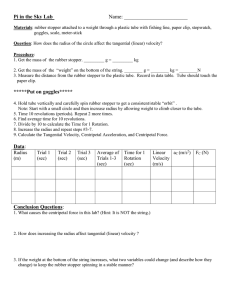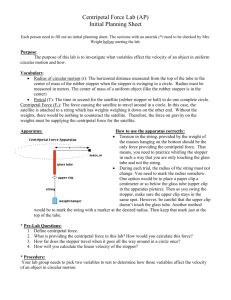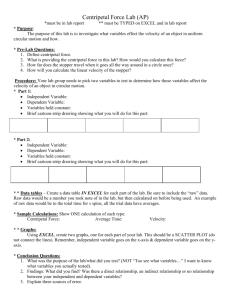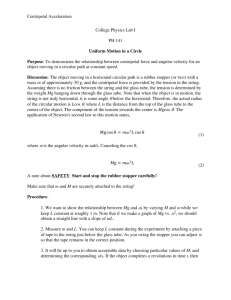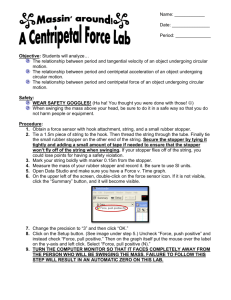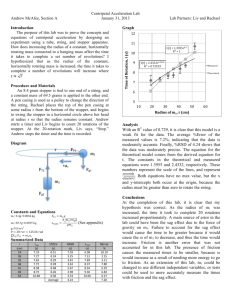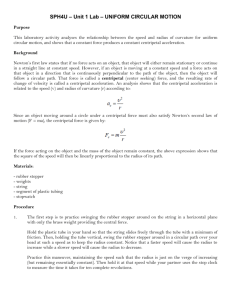Centripetal Force Lab
advertisement
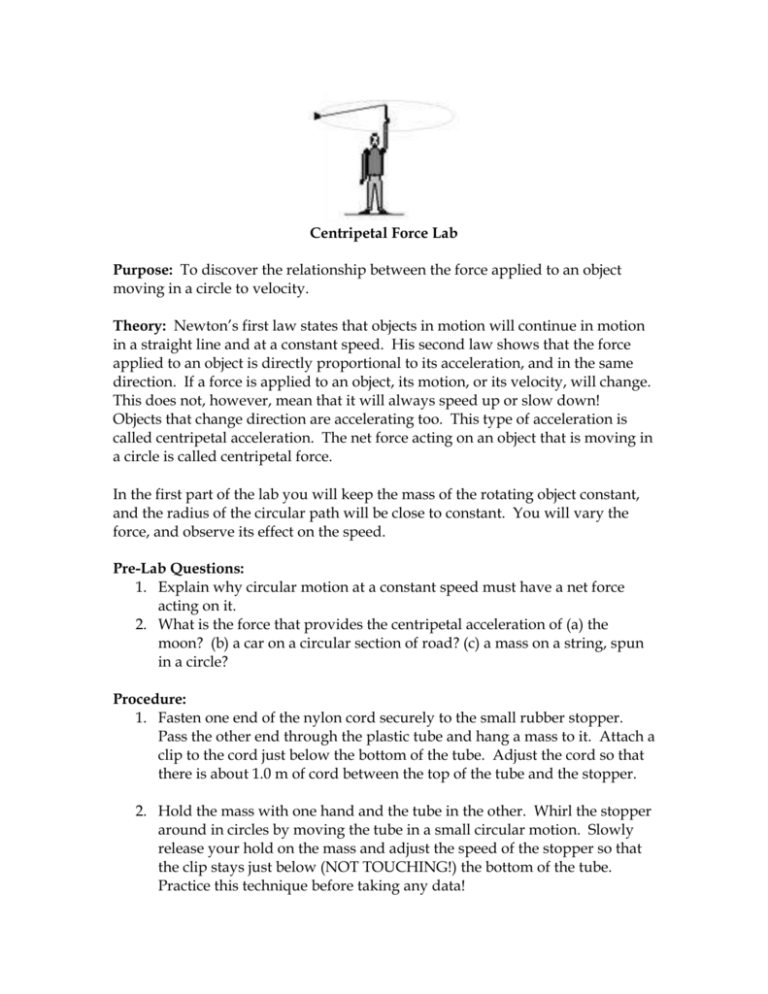
Centripetal Force Lab Purpose: To discover the relationship between the force applied to an object moving in a circle to velocity. Theory: Newton’s first law states that objects in motion will continue in motion in a straight line and at a constant speed. His second law shows that the force applied to an object is directly proportional to its acceleration, and in the same direction. If a force is applied to an object, its motion, or its velocity, will change. This does not, however, mean that it will always speed up or slow down! Objects that change direction are accelerating too. This type of acceleration is called centripetal acceleration. The net force acting on an object that is moving in a circle is called centripetal force. In the first part of the lab you will keep the mass of the rotating object constant, and the radius of the circular path will be close to constant. You will vary the force, and observe its effect on the speed. Pre-Lab Questions: 1. Explain why circular motion at a constant speed must have a net force acting on it. 2. What is the force that provides the centripetal acceleration of (a) the moon? (b) a car on a circular section of road? (c) a mass on a string, spun in a circle? Procedure: 1. Fasten one end of the nylon cord securely to the small rubber stopper. Pass the other end through the plastic tube and hang a mass to it. Attach a clip to the cord just below the bottom of the tube. Adjust the cord so that there is about 1.0 m of cord between the top of the tube and the stopper. 2. Hold the mass with one hand and the tube in the other. Whirl the stopper around in circles by moving the tube in a small circular motion. Slowly release your hold on the mass and adjust the speed of the stopper so that the clip stays just below (NOT TOUCHING!) the bottom of the tube. Practice this technique before taking any data! 3. Keeping the rate constant and the clip stationary, have a lab partner measure the time required for at least 20 revolutions to determine the period. 4. Measure the radius of the circle (the horizontal distance between the glass tube and the rubber stopper) and the mass of the rubber stopper. 5. Repeat this procedure for at least six different masses, using the same stopper on the end of the string. Try to keep the radius the same each time, but measure it carefully each time for your calculations. Data and Calculations: 1. Make a table to record all of the values of vertical mass, radius and time for each trial. 2. Calculate (and record in a table) the period and the velocity for each trial, as well as the weight of the mass on the vertical string. 3. Make a graph of velocity as a function of the weight using DataStudio. Record your observations about the shape of the graph and the relationship that it suggests. 4. Do a curve fit for your data. Press the “fit” button, and choose the power function. If the computer’s suggested fit matches your data, record the values for A, B, and n. You do not need to worry about the uncertainty, which follows the +/-. If B is a very small number, you can consider it to be about zero. 5. Write the equation that represents your curve using the values from DataStudio’s curve fit, knowing that a power equation is in the form y = Axn +B. Use your values for x and y, and the values suggested by DataStudio for A, B and n. 6. For extra credit, figure out the meaning of the constant A. What physical quantity or quantities does it represent? 7. Return to your data table, and for each trial, calculate the centripetal acceleration, ac = v2/r. 8. Create a graph of Force vs. centripetal acceleration. Record your observations about the shape of the graph and the relationship that it suggests. 9. Do a fit for your data using DataStudio (press the “fit” button, and choose the appropriate function.) Again, record the values for slope (m) and b. If b is a small number, you can considerate to be zero. 10. Write the equation that represents your data using the values from the curve fit. 11. What is the physical meaning of the slope? Compare it to what it should be, and calculate percent error. Extension: In our analysis, we kept the mass of the stopper constant and we kept the radius as constant as we could. Though we won’t investigate the effect of changing radius and mass as thoroughly as we did the changing force, we can look at a trial or two. To investigate changing radius, go back to your first trial in your data table. Keep the vertical weight the same, and keep the same rubber stopper on the end of the string. Make your radius a length of about half your original length. Record the time for 20 revolutions, and calculate period, velocity, and centripetal acceleration. To investigate changing rubber stopper mass, return to your original radius, keep the vertical weight the same, and replace the stopper with a heavier one. Record the time for 20 revolutions, and calculate period, velocity, and centripetal acceleration. Questions: 1. What is the effect of changing radius? (What happens to T, v, and ac?) 2. What was the effect of changing rubber stopper mass? (What happens to T, v, and ac?) 3. Why is the tension in the string equal to the weight of the hanging mass? 4. What force provides the centripetal force on the rubber stopper? 5. If the rubber stopper were to spin so fast as to require a centripetal force that exceeds the maximum tension in the string, what would happen? 6. If a car rounds a curve at a speed that requires a centripetal force greater that what the road can provide, what would happen?
